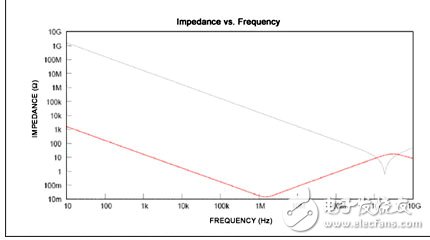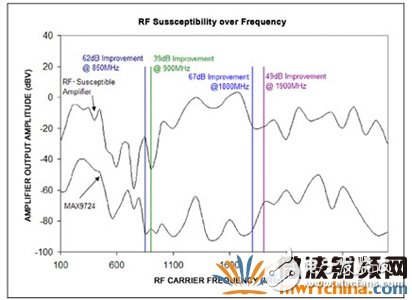Many modern audio amplifier designs overlook high-frequency RF issues, leaving them vulnerable in environments with strong RF interference. When these amplifiers are not designed to handle such interference, the RF carrier can be demodulated into the audio band, causing unwanted noise and distortion.
A clear example is the GSM (Global System for Mobile Communications) cellular network. GSM uses Time Division Multiple Access (TDMA), allowing multiple handsets to communicate with a base station simultaneously. The data transmission occurs in bursts at a rate of 217 Hz, creating an RF signal modulated at this frequency—right within the audio range. While the actual RF signals operate between 800 MHz and 1900 MHz, the 217 Hz envelope remains consistent, making it a significant source of interference.
To prevent this interference from affecting the audio quality, the amplifier in a GSM handset must either reject the 217 Hz envelope or block the electric field. The lead connecting the amplifier to the audio source acts like an antenna, especially when its length matches a quarter of the RF wavelength. For instance, at 900 MHz, a quarter wavelength is about 7.5 cm, and at 1900 MHz, it’s around 3.5 cm. Leads close to these lengths are highly sensitive to nearby RF signals, increasing the risk of interference.
As mobile phone usage continues to rise, the issue of RF sensitivity in audio amplifiers becomes more critical. Headphone and speaker amplifiers both receive RF signals, but headphone amplifiers face greater challenges due to lower signal amplitudes and more complex design considerations. Fortunately, there are several effective strategies to reduce the impact of RF noise on audio performance.
Option 1 - Integrate the Audio Amplifier into the Baseband IC
One approach to reducing RF sensitivity is to integrate the headphone amplifier directly into the baseband processor. This minimizes the lead length between the audio source and the amplifier, reducing the antenna effect. However, while this improves integration and reduces interference, it also introduces some trade-offs. Baseband processors often use low-cost amplifiers that may compromise sound quality. These amplifiers typically run on a single supply, resulting in a DC bias at the output, which requires blocking capacitors. These capacitors take up space on the PCB and can affect low-frequency response and overall audio clarity.
Additionally, integrating the amplifier near the digital baseband processor can increase noise coupling, as analog and digital circuits are in close proximity. This can further degrade the audio quality and complicate the grounding layout, making it harder to maintain clean sound output.
Option 2 - Improve Input and Power Wiring
To avoid the drawbacks of integrated solutions, using a dedicated headphone amplifier IC is a better choice. Even without built-in RF suppression, careful board layout can significantly improve performance. Input leads are particularly susceptible to RF interference, so they should be shielded and kept as short as possible—ideally much shorter than a quarter of the sensitive frequency's wavelength.
Power lines can also act as antennas for RF signals. Bypass capacitors are commonly used to filter out power supply noise, but at high frequencies, their inductance can limit effectiveness. Using a combination of a 1μF capacitor and a 10pF capacitor in parallel helps bypass the inductive effects at higher frequencies, improving noise suppression across the GSM band.

Figure 1. The amplifier's power cord picks up the RF signal.
As shown in the graph, the 1μF capacitor has lower impedance at audio frequencies, making it more effective at suppressing noise. At higher frequencies, the 10pF capacitor helps bypass the inductive effects of the larger capacitor, maintaining performance in the RF range.
Option 3 - Use an RF Suppression Amplifier
While integration and layout improvements can help, a simpler and more effective solution is to use a headphone amplifier specifically designed to resist RF interference. The MAX9724, for example, is engineered to reject RF noise without requiring special board layouts. This makes it ideal for applications where RF sensitivity is a concern.
In testing, the MAX9724 was compared to a standard audio amplifier. Both were placed in an isolated RF cavity and exposed to an electric field of 50 V/m at various frequencies between 100 MHz and 3 GHz. The results showed that the MAX9724 had significantly lower RF sensitivity, with immunity levels up to 39 dB higher than conventional amplifiers at the critical GSM frequencies.

Figure 2. Data shows that the MAX9724 effectively reduces the RF sensitivity of the amplifier compared to a normal amplifier.
At the GSM operating frequency, the MAX9724 produces almost no audible noise, even under heavy RF conditions. In contrast, standard amplifiers generate noticeable noise across all test frequencies. This makes the MAX9724 a superior choice for maintaining high-quality audio in real-world environments.
In Conclusion
RF sensitivity is a major challenge for mobile audio amplifiers. While integrating the amplifier into the baseband processor offers some benefits, it often comes at the cost of audio fidelity. Using external amplifiers with RF suppression, along with proper layout techniques, provides a more balanced solution.
Key strategies include shielding and shortening input leads to minimize RF pickup, and selecting an amplifier with built-in RF rejection to reduce noise coupling. In many cases, combining these methods can significantly improve performance. Ultimately, choosing an RF-suppressed headphone amplifier and carefully planning the PCB layout is the best way to tackle the challenges of RF interference in mobile audio systems.
Brake Disc For HYUNDAI
Hyundai Brake Disc,Hyundai Auto Brake Disc,Hyundai Car Brake Disc,Hyundai Automobile Brake Disc
Zhoushan Shenying Filter Manufacture Co., Ltd. , https://www.renkenfilter.com